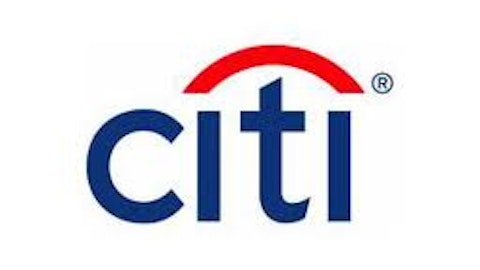While Citigroup’s performance looks pretty good, if we strip out the problem assets of Citi Holdings, the remaining company’s non-performing loan percentage drops to just 1.02%. As you can see, not only is Citigroup doing well right now, if the company can shed more of its Citi Holdings assets, this would arguably be one of the strongest banks in the country by this measure.
The second reason Citigroup may do better than people think, is the company is being very conservative in covering their problem loans. Banks regularly set aside money for problem loans, the percentage of this money set aside versus the amount of problem loans is called the coverage ratio. The higher the coverage ratio the safer the bank’s balance sheet. Many banks routinely set aside more than enough to cover their potential losses. However, if they set aside too much, they can release some of this reserve, which adds to earnings in the future.
Citigroup’s peers show a wide variation in coverage ratios. For instance, Wells Fargo & Co (NYSE:WFC) feels confident enough that its future losses will decline, that the bank only has an 88.09% coverage ratio. This means if Wells Fargo incurs losses on 100% of their non-performers, they wouldn’t have enough coverage, and they would have to set aside additional funds, which would hurt earnings. Bank of America Corp (NYSE:BAC) has a coverage ratio of 98.24%, but JPMorgan Chase & Co. (NYSE:JPM)’s coverage ratio is much higher at 179%. By comparison, Citigroup’s coverage ratio stands at 223%.
Given that Citi’s non-performing loan percentage is reasonable, this high coverage ratio could lead to better earnings in the future if the company handles its problem loans correctly.
Growth and margins
The third reason Citigroup should do well in the future is, their loan growth is outpacing their peers. In the current quarter, Bank of America Corp (NYSE:BAC) showed the worst loan growth with a decline of 0.82%. JPMorgan Chase & Co. (NYSE:JPM) saw meager loan growth of about 1%, and Wells Fargo & Co (NYSE:WFC) saw loans increase by 3.84%. By comparison, Citigroup’s loan growth of 5% looks pretty good.
A fourth reason to consider the stock is Citigroup’s net interest margin has improved. By this measure, Citigroup wasn’t the best, but they beat two of their three peers. Wells Fargo & Co (NYSE:WFC) led the way with a net interest margin of 3.48%, and Citigroup’s margin improved dramatically from last year to 2.94%. Bank of America Corp (NYSE:BAC) and JPMorgan Chase & Co. (NYSE:JPM)’s heavy involvement in asset management, trading, debt offerings, and other ventures, led these two companies to net interest margins of 2.43% and 2.36%, respectively.
When you look at the total picture at Citigroup, the future looks bright. The company is growing their loans, they are improving their net interest margin, and most importantly, their credit quality is improving. If the bank can continue to show a decline in non-performing loans, they should be able to release some of their reserve, which would add to earnings. Considering the stock sells for about 10 times forward earnings, and is already expected to grow EPS by better than 13%, any improvement in earnings growth would only add to this attractive valuation.
The article 4 Reasons This Company Could Do Better Than You Think originally appeared on Fool.com is written by Chad Henage.
Copyright © 1995 – 2013 The Motley Fool, LLC. All rights reserved. The Motley Fool has a disclosure policy.
